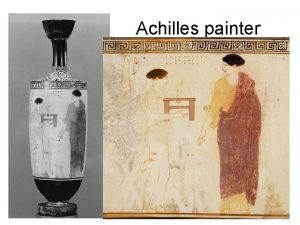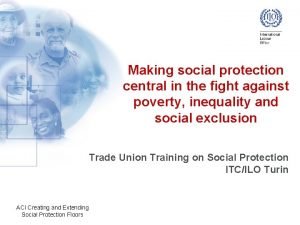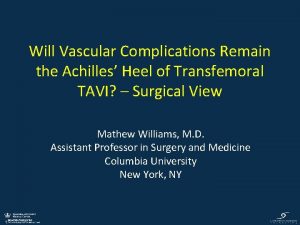Informality Addressing the Achilles Heel of Social Protection















































- Slides: 47

Informality: Addressing the Achilles Heel of Social Protection in Latin America UNU - WIDER Lecture Geneva, October 30, 2019. Santiago Levy.

Contents 1. Social protection 2. Social insurance 3. Social assistance 4. Concluding remarks

1. Social protection

Social Protection: insurance and assistance Objectives and target population Protection against risks ü ü ü Illness Longevity, death, disability Output and employment shocks All households Redistribution/poverty reduction Equity and poverty reduction as ethical imperatives, but also because with imperfect credit markets some redistribution increases efficiency Only for poor/low income households Instruments Social insurance programs Risk-pooling Usually benefits tied to contributions (often wage-based), but lots of institutional variation and recent innovation Social assistance or poverty programs Usually targeted transfers based on income or asset indicators Transfers in-kind or in-cash; sometimes conditioned on behavior (like CCTs) Almost always financed from general revenues

2. Social insurance

Background • In most countries in Latin America, and in other regions of the world, access to social insurance depends on workers status in the labor market. • Scope and quality of benefits differ, depending again on labor status. • This dependency creates substantive issues for: Ø Ø Ø The population covered The fairness of the overall system The risks against which households are protected (illness, unemployment, etc. ) The fiscal sustainability of social insurance, and The behavior of firms and workers in reaction to social insurance programs, with spillover effects on productivity and growth. • Although there are relevant institutional variations across countries, there also issues that, mutatis mutandis, are common to all.

Distinction between salaried and non-salaried labor (sometimes dependent vs. non-dependent) salaried Workers self-employed non-salaried other Salaried: have a “boss” (firm) and are paid a salary; there is a relation of subordination; workers receive orders from bosses (effort observed, coordination of tasks, and so on). Unions can be formed and minimum wages may apply; regulations on dismissal. Non-salaried: work on their own, or are associated with a firm but are not subordinated to it; contracts to share risk or elicit effort; payments take the form of commissions, profit sharing, and so on. No minimum wages (no wages!), no unions, and free dismissal (no boss!). 7

Bismarck’s inheritance: CSI and NCSI Salaried workers: bundled benefits, usually health, life and disability insurance, retirement pensions, and protections against loss of employment • • • benefits paid from earmarked wage taxes, hence the (mis)label of “contributory” social insurance, CSI benefits may also include labor training (Colombia), housing (Mexico), child allowances (Argentina) regulations on firing bundled as part of social insurance, but instead of unemployment insurance, mostly one-time severance payments at dismissal time. Non-salaried workers: until recently, uncovered by social insurance. But since 1990 s unbundled pension, health and related programs • • • benefits paid from general revenues, hence the (mis)label of “non-contributory“ social insurance, NCSI benefits targeted to workers not covered by CSI (often regardless of whether they are salaried or not) no costs of firing or minimum wages.

Formality and informality • Defined with reference to a specific regulation (Kanbur). • Many regulations possible (compliance with registration, tax obligations, size…) • In LA, reference usually is coverage of CSI: Formal workers are covered by CSI programs; informal workers by NCSI programs. • All formal workers are salaried, but informal workers can be salaried or nonsalaried (since firms may break the Law). • Informality and illegality not the same (but this depends on countries’ laws).

Contributory social insurance Basic workings: Worker hired by firm under a salaried contract and paid a wage w* Contribution is TCSI (usually expressed as a proportion of w*) Firms pay : (w* + TCSI) Worker gets: w* in cash and TCSI in health, pension and other benefits Benefits can be provided by public or private institutions, and the pension component can be PAYG or DC (but these aspects not relevant here) Even though the firm “pays” for CSI, workers may in large part end up paying in the form of a lower wage (if w** > w*, where w** is the wage that workers would get if there was no CSI)

Three problems with CSI 1. Limited coverage: By construction, CSI applies only to workers who have a salaried job and whose firm complies with the law; many are legally left out: the self-employed, rural workers, part -time workers, workers in family firms……. and many illegally left out. But even under full compliance, CSI will not deliver universal coverage. Rates of informal employment in Latin America. 90 80 Average = 56% 60 50 40 30 20 10 ile Ch y ua ug Ur Co st a. R ica il az Br gu a Ho nd ur as Gu at em Do al m a in ica n Re p. El Sa lva do r Ec ua do r Co lo m bi a M ex ico Ve ne zu el a Ar ge nt in a Pa na m a ru ca ra Ni Pe ay gu Pa ra liv ia 0 Bo Percent 70

2. Under-valuation of benefits: • Workers might consider that TCSI is worth less to them (because of quality problems, trust, or simply differences in preferences from the government). • In this case, there is an implicit tax on formality: firms pay (w + TCSI), but workers get (w + TCSI), with . • This tax will induce firms to limit salaried employment and/or to evade the Law. • In either case, the result will be reduced legal salaried employment, further reducing the coverage of CSI. • Bobba, Flabbi and Levy (2018) estimate that = 0. 55. Since TCSI = 0. 30, the implicit tax is quite large, about 14% of the wage in the case of Mexico.

Evidence from CSI programs Reducing the tax on formality: 2012 reform in Colombia Share of workers contributing to pensions 49. 0 Health Contributions 50 Reduction in pay-roll tax 49 46. 7 47. 5 12. 5 48 43. 7 42. 0 41. 9 41. 4 43 42. 1 44 41. 9 4. 0 43. 2 45 42. 8 44. 4 46 44. 5 47 42 40 Ene - Mar 07 Abr - Jun 07 Jul - Sep 07 Oct - Dic 07 Ene-Mar 08 Abr - Jun 08 Jul - Sep 08 Oct - Dic 08 Ene - Mar 09 Abr - Jun 09 Jul - Sep 09 Oct - Dic 09 Ene - Mar 10 Abr - Jun 10 Jul - Sep 10 Oct - Dic 10 Ene - Mar 11 Abr - Jun 11 Jul - Sep 11 Oct - Dic 11 Ene-Mar 12 Abr-Jun 12 Jul-Sep 12 Oct-Dic 12 Ene - Mar 13 Abr-Jun 13 Jul-Sep 13 Oct - Dic 13 Ene - Mar 14 Abr - jun 14 Jul - sep 14 Oct - dic 14 Ene - Mar 15 Abr -jun 15 Jul - sep 15 Oct - dic 15 41 • Two health care regimes: subsidized for informal workers and contributory (higher quality) formal ones. • In 2008 the Constitutional Court ruled that the quality of both systems should be the same. • Tax reform in 2012 reduced the health contribution formal employees from 12. 5 to 4 percentage points.

3. Large transits across labor status Probability of change of status in one year

Implications for social insurance • Distinction between “formal worker” vs. “worker at present hired formally”. Many workers have spells of formal and informal employment during their life-cycle. • Only when workers are formal do they save for retirement, get severance pay, and receive similar benefits that are typically not provided by NCSI programs. • Coverage against risks erratic and incomplete: when formal CSI bundle, when informal, NCSI benefits. • Efficiency of social insurance much diminished: Ø workers get lower quality health care (interrupted treatments), Ø many will not get a CSI pension (insufficient years of contribution). 15

Example: Formal-informal transits in Mexico Retirement pensions Ø Average contribution density between 1997 and 2015 of 43%. Ø Large variance: Density 0 - 20 20 - 40 40 - 60 60 - 80 80 - 100 Share of workers 39 16 11 12 23 Ø Two out of every three workers saving for a pension will not qualify for one! Health Ø In 3 years, 32% of patients with type 2 diabetes receiving CSI benefits transit into informality. Interrupted treatments result in a 43% decrease in quality of care, and 19% fall in clinical results (Doubova et al. , 2018). Ø One out of every two workers will not qualify for CSI health benefits after retirement.

Non-contributory programs to the rescue? • Beginning in the 1990’s, many countries in LA have made efforts to extend the coverage of social insurance to workers excluded from CSI, through NCSI. • NCSI programs are unbundled and financed by the government, with no firm involved. • There is substantial variation across LA in terms of what these programs offer, but in most places they involve health services, retirement pensions, and sometimes other benefits (e. g. , day care services in Mexico, family allowances in Argentina).

Benefits and costs of non-contributory programs • From a social point of view, NCSI programs are clearly welcome, as they provide benefits to workers who would otherwise get none, even if the scope of benefits is less than those provided by contributory programs. • However, from the economic point of view these programs represent a subsidy to informality, which adds to the effects of the tax on formality associated with undervalued contributory programs, and lower formal employment and productivity. • There also implications for national savings, to the extent that the number of workers saving for a pension is reduced as informal employment is stimulated. • Finally, there are fiscal implications as NCSI do not have a direct source of revenue.

0 Growth rate Employers in IMSS. 1. 2 . 3 Evidence from NCSI programs, Mexico 1997 q 3 2001 q 1 2004 q 3 2008 q 1 2011 q 3 Year-quarter Implemented in 2002 -2003 Reviewing the various papers, Bosch and Pages (2012) find that from 2002 to 2010, Seguro Popular reduced formal employment by between 160, 000 to 400, 000 jobs, or between 8 and 20% of all formal jobs created during that period. Implemented in 2006 -2007 This difference also provides indirect evidence of higher evasion by firms.

Evidence from subnational NCSI programs, Mexico Effect of the Mexico City Health Program for Women The probability of formal employment fell by 8%. Guadalajara and Monterrey Mexico City Source: Juárez (2008). 20

Evidence from NCSI programs, Argentina Effects on labor informality of extending child allowances (AUH) to informal workers (% of informal workers that become formal) The extension of child allowances to informal workers reduced substantially the rates at which these workers entered formal employment. Source: Garganta & Gasparini (2015)

Evidence from NCSI programs, Argentina Start of moratoria 0. 35 0. 03 0. 02 0. 25 0. 01 0. 2 -0. 02 0 /1 10 0 /1 05 9 /0 10 9 /0 05 8 /0 10 8 /0 05 7 /0 10 7 /0 05 6 /0 10 6 /0 05 5 /0 10 5 /0 05 4 /0 10 -0. 01 /0 4 0 05 Share of women working Difference between women 60 -64 & 55 -59 0. 04 0. 15 0. 1 -0. 03 -0. 04 -0. 05 Share of women with a pension Difference between women 60 -64 & 55 -59 Share of women working and retired with a Moratoria pension The moratoria reduced women’s participation rate by 4 percentage points among those aged 60 -64. 0 The moratoria gave women over 60 access to a pension without having made any contributions to social insurance, or with incomplete contributions.

Evidence from NCSI programs, Uruguay Effects on labor informality of family allowances (AFAM) Workers who do not qualify Workers who qualify In Uruguay, the AFAM reduced registered (formal) employment by Extending family allowances to poor informal workers reduced formal employment by 7. 5 percentage points, from 48 to 41. 5 percent. Source: Garganta & Gasparini (2015)

Methodological observation Ø Countries operate many NCSI programs in parallel. Further, NCSI programs co-exist with CSI programs. Ø What matters is the combined effect of all CSI and all NCSI programs, i. e. , the combined effect of the tax on formal labor and the subsidy to informal labor. Ø Few papers look at the full impact of [CSI + NCSI], as it is almost impossible to do so with standard econometric techniques that allow proper identification; that is, we want to know: but most papers (like the examples above) measure individual program j: or vectors Ø Anton, Hernandez and Levy (2012) simulate the joint effects of [CSI + NCSI] programs in Mexico, and find that they reduce formal employment by 26% and increase informal employment by 45% relative to the equilibrium with TCSI = TNCSI = 0.

Implications for productivity of CSI-NCSI dichotomy Ø Firms and workers respond to the asymmetry in the regulation of labor implicit in the CSI-NCSI dichotomy. These responses depend on: ü for firms, differences in expected costs of a salaried vs. non-salaried contract, possibilities of substitution between them, possibilities of evading regulations on salaried labor (enforcement and fines) ü for workers, the expected utility of each contract (earnings, social benefits, other dimensions of the job). Ø Given all other taxes, credit regulations, and so on, these responses impact: ü the type and size distribution of firms: w/wo salaried contracts, legal/illegal, family firm, one-person firm ü the efficacy of social insurance (who is covered against what risks, and how often) ü the fiscal costs of social insurance ü investments in labor training, adoption of technology and innovation, rotation of workers, tenure, etc.

Structure of labor contracts under the CSI-NCSI dichotomy Contrat Expected cost to firm Expected benefit to worker Implicit tax or subsidy Formal employment Legal salaried Illegal salaried Informal employment Non-salaried TCSI = monetary cost of the bundle of contributory social insurance benefits (including contingent costs) TNCSI = monetary value of all non-contributory social insurance programs = worker’s valuation of TCSI ; = worker’s valuation of TNCSI. = expected penalty for violating a salaried contract (usually increasing in firm size). Note: informal employment has a legal and an illegal segment. Under perfect enforcement, its illegal segment would disappear as long as F > TCSI. ,

Two distortions : firm type and firm size Costs of Labor in Mexico Cost of labor to firms that evade: profit maximizing combination of legal and illegal salaried contracts, given imperfect enforcement. Cost of legal salaried labor Average cost of labor contract 10% (tax on formality) Cost of labor without the formal – informal dichotomy 24% 14% (subsidy to informality) Informales bajo SSNClabor Cost of non-salaried • • • All firms with non-salaried contracts regardless of size subsidized; All cheating firms with up to 7 salaried workers subsidized; Firms with 8 or more salaried workers taxed, increasing with size. 27

Mexico, Firms and Resources, 2013 TYPE 73% informal & legal 17% informal & illegal 10% formal FIRMS SIZE (# of workers) 91% 1 – 5 8% 6 – 50 1% 51 + WORKERS 40% informal & legal 16% informal & illegal 44% formal 40% 1 – 5 23% 6 – 50 37% 51 + CAPITAL 33% informal & legal 9% informal & illegal 58% formal 19% 1 – 5 22% 6 – 50 59% 51 + Informality Average firm size = 4. 2 (but 3. 7 considering firms in mobile premises). All: 90% of firms; 56% of labor; 42% of capital. Legal segment largest: 73% of firms; 40% of labor; 33% of capital.

Informal firms are less productive than formal ones Mexico, TFP relative to formal Number of employees 0 -5 6 -10 11 -50 50+ 0 Other factors like the tax regime and credit issues also contribute to these results. -10 -20 -30 -40 -50 Informal firms with salaried workers (ilegal) -60 Informal family firms (legal) But the wedges in the cost of labor associated with the CSI-NCSI dichotomy play a central role. -70 Comparisons of firm-level TFP for a universe of 3. 6 million firms grouped at 6 -digit level. 29

The current architecture of social insurance may create a vicious circle between informality and low productivity CSI: exclusion by design, low valuation and imperfect enforcement = reduced formal jobs Informal firms de facto subsidized, formal firms taxed = low productivity, evasion NCSI programs to extend coverage = value of informal jobs increased Taxes on the formal sector and subsidies to the informal sector (also by tax regime and other) = lower public investment or more debt 30

The policy problem “Stop promoting “Improve social welfare” informality” We need to increase productivity and wident the tax base! We need to expand the coverage of social insurance to all households! ( …. with whatever combination of programs and sources of revenues) The nature of this trade-off varies from country to country and program to program, and while more research is needed, it is clear that a dual social insurance architecture can hurt productivity and growth. 31

In sum • Formal/informal segmentation of labor markets in LA very much associated with the dual architecture of social insurance (initially only CSI and more recently NCSI programs). Social exclusion inherent to the design of social insurance. • The CSI/NCSI divide is worrisome: the same person, with the same education, sometimes has access to some benefits and sometimes not. Along critical social dimensions (access to life insurance, obligation to save, quality of health care), he/she is treated differently, sometimes for reasons beyond his/her control. • The CSI/NCSI divide is also worrisome, as it reduces productivity and deteriorates the quality of jobs. Workers lose doubly. • Finally, the current system forces the government to face sharp trade-offs.

The case for universal social insurance • Most governments recognize access to basic education as a universal right, and structure the financing and provision accordingly. • But in LA that same recognition is not extended to health care, and to protections against related risks like death, disability and longevity. • In these cases, coverage has evolved in a very ad-hoc manner, resulting in unfair and inefficient outcomes. • A strong case can be made to treat at least some key elements of social insurance as a social right of all workers, to be provided with the same quality or scope to all, and funded from the same source of revenue (as public education).

• There are many variants to this proposal, but a guiding principle can be the following: Ø “Risks that are common to all workers –like illness, death, disability and longevity– should be funded from the same source of revenue and provided to all with the same quality/scope, and Ø Risks that are associated with a specific type of labor –like being fired by a boss or insufficient safety in the workplace– should be funded from a source of revenue specific to that type of labor” • This principle needs to be adapted to specific country circumstances, calibrated given fiscal space, and so on. But it would provide a compass for the re-design of social insurance in ways that would make it more inclusive, more effective, and friendlier to productivity.

3. Social assistance

Will CCTs break the intergenerational transmission of poverty ? more human capital • Two conditions: better income opportunities, especially more productive jobs • Unless the poor obtain higher earnings with their own efforts, CCTs run the risk of being a permanent scheme to transfer income to the poor, rather than a temporary investment in their human capital. • CCTs are not: ü “job-creating programs”, ü ü programs to respond to temporary shocks in output substitutes for social insurance programs. 36

Objetive: Redistribution Objetive: Insurance against risks Formal Informal Non. Poor CCTs redistribute while investing in human capital. Poor This is a “row” issue, not a “column” issue. 37

Incentive incompatibility between social insurance and social assistance Social assistance: Poor workers’ future CAPABILITIES CCTs subsidize the demand for health and education of poor children and youngsters. Social insurance: Workers’ and firms’ INCENTIVES CSI and NCSI programs tax formality and subsidize informality Labor market OUTCOMES Persistent informality despite increases in workers’ human capital. Ø CCTs cannot solve the problems created in the labor market by the formal-informal dichotomy. Ø Mexico’s CCT (Progresa-Oportunidades) costs about 0. 5% of GDP. Ø However, Mexico channels 2% of GDP to NCSI programs. 38

Labor market outcomes for the poor are disappointing Mexico, 2005 -2019 Coverage of CSI is very low, and has fallen slightly, despite increases in years of schooling! Workers in first two deciles of the earnings distribution working 20 hours or more, aged 20 to 65 in urban areas (15, 000 people or more).

A simplified but useful perspective Productivity F B NP . I C . EI = earned income T = transfer Income EI P EI . T A Young poor workers may be healthier and more educated than their parents as a result of CCT’s but they will not access better jobs. 40

4. Concluding remarks

Social insurance Ø The combination of CSI and NCSI is bad social policy (lowers the efficacy of insurance) and bad economic policy (hurts productivity and the tax base). Ø Countries need to escape from the dilemmas created by the CSI-NCSI dichotomy. There are strong equity and efficiency reasons for “universalism”. Ø This is a tall order, as it inevitably involves tackling fiscal issues (what revenue sources should replace CSI contributions? ) and challenging long-held paradigms (don’t CSI contributions redistribute income from “capital” to “labor”? ).

Social assistance/poverty Ø Income transfer programs for the poor (like CCTs) should focus on transferring income while investing in human capital; nothing else. Ø In parallel, poor workers should be protected against risks through the same mechanisms as all other workers (i. e. , by the same social insurance programs). Ø A well-functioning labor market is essential for the poor, and this should not be substituted for by other programs (micro-credit? ). Ø Consequently, a well-functioning social insurance system is part of a strategy to combat poverty. Ø More or better NCSI programs for the poor give with one hand, and take away with the other.

Social protection Ø It is essential to make a distinction between social insurance and social assistance/poverty programs. We need a clear view of the objectives of each program, the instruments used to pursue them, and the target population. Ø Universalism and targeting can and should co-exist. Ø Extending coverage and improving quality are key objectives for those concerned with social protection in developing countries. Ø LA’s experience shows that it is central to consider the incentives implicit in social programs: Who qualifies for what? Who pays for what? How do firms and workers react to those rules, differences in revenue sources and in quality of services?

Ø Debate centers on “architecture” of social protection, not on individual programs. Ø Need to go beyond the usual impact evaluation of individual programs and understand how programs interact. Reforms of individual programs, or creation of new ones, can be risky without a systemic view. (The individual pieces of a watch might be very pretty, but they need to all fit together if the watch is to give the correct time. ) Ø These issues need urgent attention. Countries may be constructing Welfare States in economies characterized by permanent informality, weak fiscal basis and low productivity growth.

“The ideas of economists and political philosophers, …. , are more powerful than is commonly understood. Indeed the world is ruled by little else. Practical men, who believe themselves to be quite exempt from any intellectual influences, are usually the slaves of some defunct economist. I am sure the power of vested interests is vastly exaggerated compared with the gradual encroachment of ideas…. But it is ideas, not vested interests, which are dangerous for good or evil”. J. M. Keynes, The General Theory In matters of social protection, it may well be the opposite: it is economists who are the slaves of a defunct politician.

Thank you.
 Whos achilles
Whos achilles Is the iliad a tragedy
Is the iliad a tragedy Who said to be or not to be
Who said to be or not to be Achilles heel example
Achilles heel example Allusion of achilles heel
Allusion of achilles heel Achilles heel allusion example
Achilles heel allusion example The achilles heel of international strategy is that:
The achilles heel of international strategy is that: Heel toe polka dance steps
Heel toe polka dance steps Flat addressing vs hierarchical addressing
Flat addressing vs hierarchical addressing Achilles father
Achilles father Achilles and ajax playing dice
Achilles and ajax playing dice Richtlijn achillespees tendinopathie
Richtlijn achillespees tendinopathie Achilles lover
Achilles lover Prophylactic tape
Prophylactic tape Tendon injuries clinton
Tendon injuries clinton Chiron griechische mythologie
Chiron griechische mythologie Birthplace of achilles
Birthplace of achilles Shooter mbti
Shooter mbti Achilles hero journey
Achilles hero journey Peleus
Peleus Achilles tendon rupture moi
Achilles tendon rupture moi Death of achilles
Death of achilles Achilles bajka
Achilles bajka Achilles tendon rupture moi
Achilles tendon rupture moi Exekias achilles and ajax playing a dice game
Exekias achilles and ajax playing a dice game Achilles painter
Achilles painter Telefono achilles controlar
Telefono achilles controlar Achilles painter
Achilles painter The achilles painter
The achilles painter Achilles outline
Achilles outline Epic greek tale that's paired with the iliad
Epic greek tale that's paired with the iliad Apa itu social thinking
Apa itu social thinking Social thinking social influence social relations
Social thinking social influence social relations Social protection operational framework philippines
Social protection operational framework philippines Social protection instruments
Social protection instruments Social protection operational framework philippines
Social protection operational framework philippines Social protection
Social protection Handling information in health and social care
Handling information in health and social care Ilo social protection
Ilo social protection Heel and toe arrangement in carding
Heel and toe arrangement in carding Heel clearance in railway
Heel clearance in railway Overlap gate injection molding
Overlap gate injection molding Heel and trim
Heel and trim Truss blocking requirements
Truss blocking requirements Bremsstrahlung
Bremsstrahlung Rotating anode
Rotating anode Supraspinatus taping
Supraspinatus taping Line focus principle
Line focus principle

































































